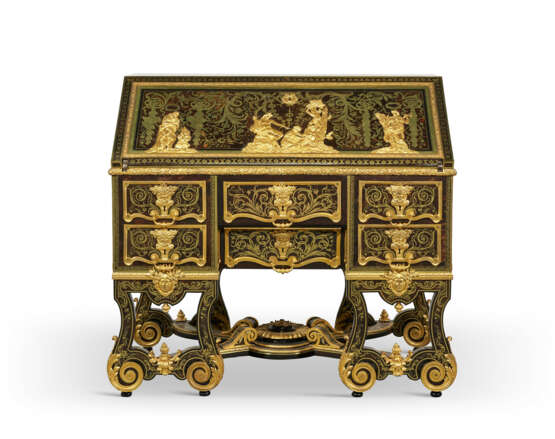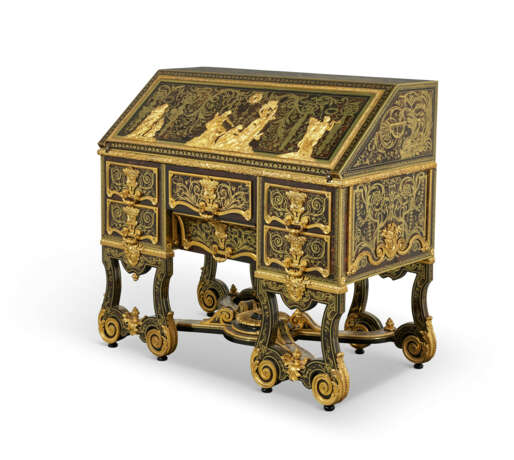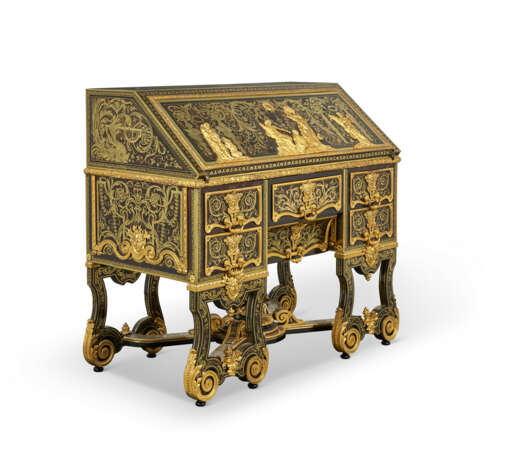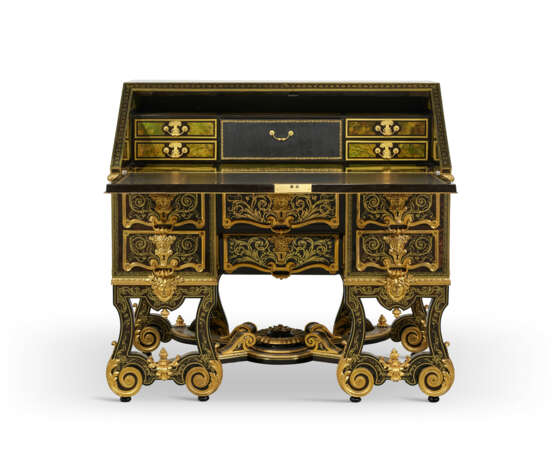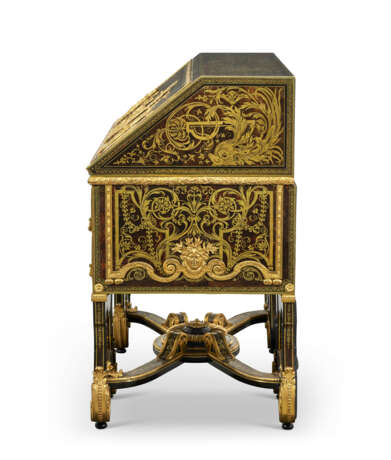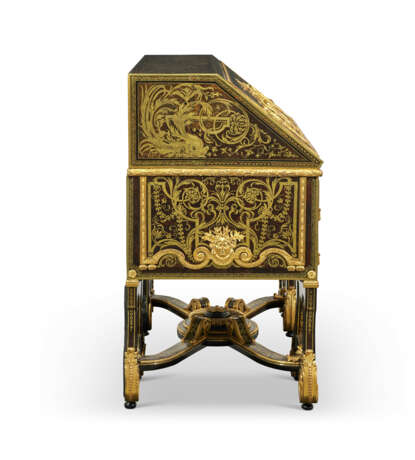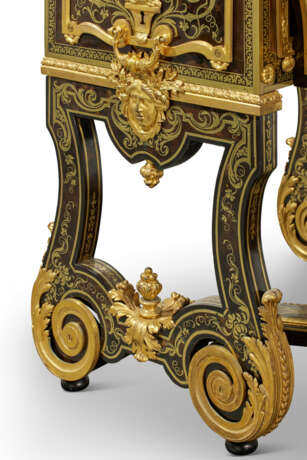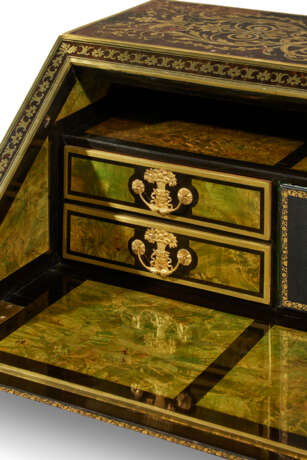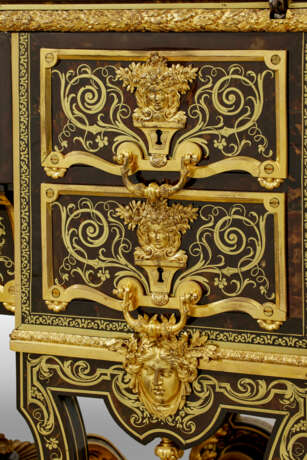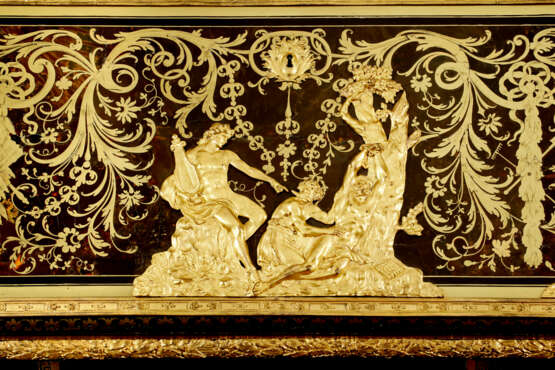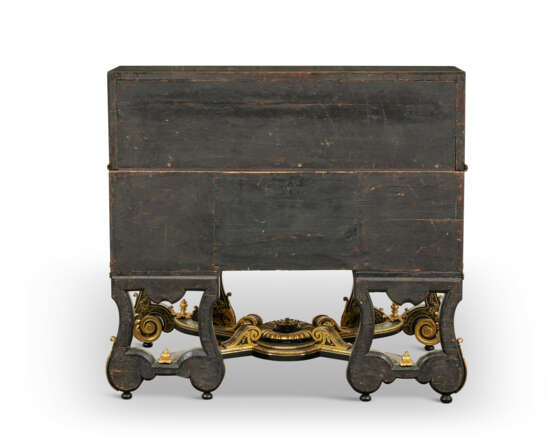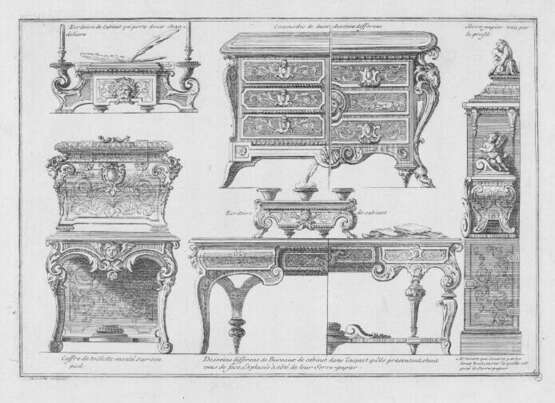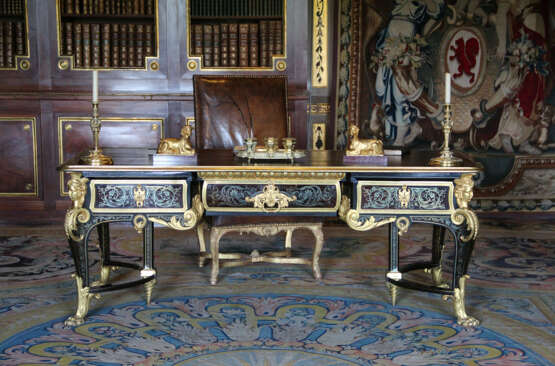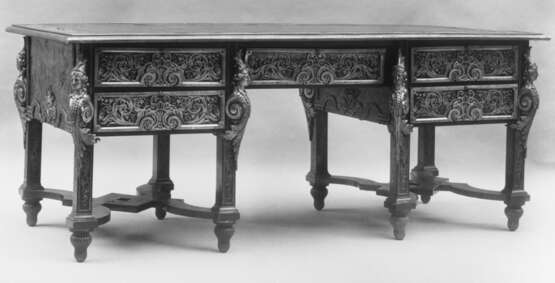ID 1329904
Лот 20 | BUREAU DE PENTE LOUIS XIV
Оценочная стоимость
€ 100 000 – 150 000
ATTRIBUÉ À ANDRÉ-CHARLES BOULLE, FIN DU XVIIe SIÈCLE, LA SECTION HAUTE D’ÉPOQUE LOUIS XVI
En placage d'ébène, loupe de sycomore teinté en vert, marqueterie Boulle d'écaille de tortue caouanne et de tortue à écailles imbriquées, et de laiton, ornementation de bronze ciselé et doré, ouvrant en partie supérieure par un abattant orné d'Apollon et Marsyas encadré des figures de l'Hiver et de l'Eté, découvrant une tablette d'écriture gainée de cuir doré à la roulette, un coffre central et quatre tiroirs d'époque Louis XVI dont un comprenant un nécessaire à écriture, à décor simulant l'écaille de tortue, appliqués de poignées centrées de satyres chapeautés de bouquets de fleurs, les côtés appliqués de masques d'Apollon et de guirlandes de lauriers, à décor postérieur de dauphins et de rinceaux feuillagés, la partie inférieure ouvrant par six tiroirs à encadrements appliqués de masques de Daphné et d'Apollon ; reposant sur huit pieds en enroulements réunis par une entretoise centrée de rosaces godronnées ; réadapté sous Louis XVI en bureau de pente
H. 107 cm. (42 in.) ; L. 117 cm. (46 in.) ; P. 64 cm. (25p in.)
Provenance
Probablement collection de M. Montullé, vente à Paris le 22 décembre 1783, lot 311 ;
Collection de François-Michel Harenc de Presle, vendue à Paris le 16 avril 1792, lot 402, puis le 30 avril 1795, lot 252 à Lebrun Jeune ;
Collection de Lady Lavinia Bertie ;Vente Sotheby's Paris, 9 avril 2008, lot 72 ; Collection privée française.
Literature
Cat. expo., André-Charles Boulle, sous la dir. de M. Deldicque, Musée Condé, château de Chantilly, 8 juin - 6 octobre 2024, p.101 (illustré).
Further details
A LOUIS XIV ORMOLU-MOUNTED EBONY, SYCAMORE AND BRASS AND TORTOISESHELL BOULLE MARQUETRY DESK ATTRIBUTED TO ANDRÉ-CHARLES BOULLE, LATE 17TH CENTURY, THE UPPER PART LOUIS XVI
A work typical of André-Charles Boulle's creations
This Mazarin desk, transformed into a sloping desk during the reign of Louis XVI, is typical of the work of André-Charles Boulle. In addition to its recognizable, but much imitated, marquetry, certain elements confirm this attribution.
The decoration of this desk, depicting the story of Apollo, on the one hand with Daphne and on the other with Marsyas, is a recurring theme in the cabinetmaker's creations. This theme, taken from Ovid's Metamorphoses, is the guiding thread in the decoration of this piece: the front and sides are adorned with masks of Daphne adorned with laurel leaves, into which she was transformed to escape Apollo. As for Marsyas, condemned to be hung from a tree and flayed alive for having measured his musical talent against that of Apollo, he is represented here in the center, the flute at his feet opposite his executioner holding his lyre, pointing to him for his torment. Boulle had already associated these two themes in several pieces, such as the Histoire d'Apollon cabinet (1695-1700, formerly coll Leboudy and Givenchy, illustrated in J. Nerée Ronfort, André Charles Boulle, Un nouveau style pour l'Europe, Paris, 2009, p. 73 ), a cabinet sold by Philipps on December 5, 2001 in New York and a cabinet from the Royal Collection of England, held at Windsor Castle (RCIN 21642). The Marsyas group, identical to ours, is found here, while the Daphne theme is illustrated by Apollo pursuing Daphne as she transforms into a laurel tree.
The Daphne masks on the sides of our desk, framed in gilt bronze with scrolls and foliage, are identical to the one on a desk attributed to André-Charles Boulle in the Metropolitan Museum, New York (inv. 37. 160. 7), from the former Ogden Mills collection, the counterpart of which was sold at Christie's in New York on November 2, 2000, lot 179. Another of the cabinetmaker's desks features the same Daphne masks, scrolls and foliage, as well as the same ormolu frames and moldings that extend them, frame the drawers and underline the edges (illustrated in ds J. Nerée Ronfort, André Charles Boulle, Un nouveau style pour l'Europe, Paris, 2009, p. 204). These master models, such as these Daphne masks and volutes, were therefore carefully preserved in the workshop for re-use.
The scrolls, centered on a motif and surrounded by frames, underline the lower crossbeam of the sides of this desk, echoing the manner in which Boulle scrolled his table belts and cabinet bases, and in particular a pedestal cabinet, circa 1680, preserved at the Getty Museum (77. DA. 1). The veneered scrolls, which follow the cut-out of the cabinet's crossbeam, are here simply replaced by gilded bronze and metal marquetry.
Some of the other bronzes on this desk are also found on several Boulle pieces and engravings, such as the leafy scrolls on the eight legs, which appear on engravings after Boulle published by Mariette, on a flat desk by the cabinetmaker from 1710 -1715 preserved at the Château de Vaux-le-Vicomte in Maincy and on two desks in part and counterpart of the Colbert de Torcy model, attributed to André-Charles Boulle, now in private collections.
Other features of this desk are part of André-Charles Boulle's ornamental vocabulary: the design of the brace, notably decorated with posts, which can be seen on several engravings after Boulle published by Mariette; the scrolling of the legs, featured on numerous occasions on pedestal tables, tea light stands, certain cartels and brackets marking low bookcases; but also the figures of the seasons, a leitmotif of the cabinetmaker's work.
The marquetry panels are equally characteristic of the work of André-Charles Boulle. The dolphin decoration on the sides is based on an engraving by Jean-Philippe Boulle, the cabinetmaker's eldest son, held in the Bibliothèque de l'Arsenal, and faithfully reproduced here. This same decoration is also inlaid on two rectangular tables by André-Charles Boulle, known as brandons, circa 1701, one in Bowhill House and the other in the Victorian and Albert Museum. Boulle's eldest son played a major role in the workshop, participating directly in the design of the models, even if he was not the creator.
Similarly, panels of leafy interlacing marquetry similar to those on this desk appear on the right-hand rear panel of the desk in the Metropolitan Museum, New York (inv. 37. 160. 7), from the former Ogden Mills collection and its counterpart sold at Christie's mentioned above.
This ornamental grammar, found in Boulle's work throughout his career, is particularly characteristic: from a central bronze bas-relief, a symmetrical, three-lobed marquetry emerges, articulating and intertwining broad rinceaux finished with tapering leaves.
An embodiment of the genius of the greatest cabinetmaker of the reign of Louis XIV
Above all, this desk embodies the genius of André-Charles Boulle: his mastery of design, carpentry, cabinetmaking and sculpture - all of which he was able to practice thanks to a royal privilege - the excellence of his skills in the service of the Crown, and the multitude of innovations he developed in marquetry, gilded bronzes and desk shapes.
German by birth, like most of the great cabinetmakers of 17th-century France, André-Charles Bolt, Frenchized as Boulle, practiced in Paris in the context of the absolutist cultural policies pursued by Louis XIV, who aspired to make Paris the capital of art and luxury in Europe.
In 1672, at the age of thirty, he was noticed by Colbert and recommended to Louis XIV, who appointed him the King's cabinetmaker and granted him a workshop in the Louvre and a royal privilege, enabling him to escape the rules of the guilds.
With over 1,000 square meters of floor space and more than fifteen journeymen, not to mention his other assistants and apprentices, Boulle's workshop reached a level of development in the late 1680s that was unrivalled under the Ancien Régime, in terms of both its size and the diversity of its specialized staff. In 1685, he even set up his own foundry, while stocking his workshop with a wide variety of woods, including fir, oak, walnut, cherry, Norway wood, ash root, ebony and sandalwood. Particularly gifted in working with exotic woods, he also mastered drawing and copper engraving, which he drew on his training as a foundryman, chaser and gilder. Boulle was not only an engraver, but also one of the greatest collectors of prints of his time, which inspired his creations. His after-death inventory lists two hundred and sixty-three portfolios containing over ten thousand prints, from Dürer to the modern masters.
Between 1672 and 1714, Boulle produced some twenty pieces of furniture for the royal family, working in the King's building department. He also delivered to several princes, including the Duc d'Orléans, the Prince de Condé and the Duchesse de Berry; to ministers such as Louvois, Desmarets and Pontchartrain; to financiers and government officials such as Samuel Bernard and Pierre Crozat; to church dignitaries such as Cardinal de Rohan; and to foreign princes such as Philip IV of Spain and the Elector of Cologne, Joseph Clement of Bavaria. He welcomed Bernini to his studio in 1665 and Tsar Peter the Great in 1717.
But above all, this desk illustrates the many innovations that André-Charles Boulle developed in all areas of cabinetmaking. This marquetry is the synthesis of what his predecessors never managed to achieve: the simultaneous use of wood, brass and tortoiseshell, enhanced by gilded bronzes. Their juxtaposition required new technical solutions, such as the interposition of thin sheets of white linen paper to preserve the impact of the colors, colored fillers and appropriate binders, special work on the reverse side of the surfaces to facilitate adhesion, or the chemical treatment of brass with acid. Although he was not the initiator, Boulle brought brass and tortoiseshell marquetry to such a degree of perfection that it took his name.
Similarly, the gilded bronzes on this desk bear witness to the major role they played in Boulle's furniture design. Indeed, while the primary function of bronze ornamentation was to frame and protect the ends of furniture, from the 1690s onwards Boulle gave it the leading role. The figures of Apollo, Marsyas, Daphne and the Seasons are thus the central elements of the decorative organization, around which the marquetry unfolds in symmetry. Likewise, the Daphne masks adorned with foliage volutes are the starting point for a series of foliage falls that descend to the ends of the feet. Here, Boulle achieves a subtle interplay between marquetry and bronze decoration, one seeming to be an extension of the other; the power and finesse of the bronze chasing responding to the gracefulness of the inlaid decoration.
This office is also the result of the evolution of different forms of offices, to which Boulle has contributed considerably, as evidenced by his collection of engravings New designs of furniture and works of bronze and marquetry from 1708. He is also credited with creating certain types of furniture, including the dresser and flat desk. The latter first has eight feet, then lightens, loses its central cabinet, lies down, then frees up two and then four feet. This Mazarin desk is thus one of the oldest versions of desks made by Boulle. Despite its late name, the office of Mazarin did not appear until 1670-1680, well after the death of the cardinal. Characterized by eight feet and two lateral boxes with three drawers, each resting on four legs joined by a spacer, it is often centered of a drawer overhanging a leaf. Much more rarely, a drawer is used instead of the leaf, as here.
But this desk is not only a Mazarin desk, it's also a sloping desk. This type of furniture didn't develop until the 1730s, suggesting that it would have been revived much later.
A witness to the evolution of taste in furniture during the reign of Louis XVI
While it represents the apogee of artistic and decorative creation during the reign of Louis XIV, this sloping desk also illustrates, almost a century later, the evolution of furniture fashions during the reign of Louis XVI. In its original form as a Mazarin bureau, it most probably corresponds to the one that belonged to Monsieur de Montullé during the last quarter of the 18th century. Cousin of the famous collector Jean de Jullienne, Jean-Baptiste-François de Montullé was State Councillor, then Secretary of Command to Queen Marie Leczinska, then to the young dauphine Marie-Antoinette. Owner of the famous dye factory developed by his cousin Jullienne, he was already mentioned in 1762 in Hébert's Dictionnaire pittoresque et historique, was an honorary member of the Académie de peinture et sculpture, and owned a substantial collection of paintings and sculpture, which was sold during his lifetime in 1783. In its sale in Paris on December 22, 1783, in a chapter entitled “Meubles de Boule”, which includes the only piece of furniture in the sale attributed to André-Charles Boulle, it is described as follows: « 311 Un très beau bureau de Boule, première partie, à deux faces ; il est composé de six tiroirs ornés de poignées de masques de femmes, et bordés chacun en bronze ; les deux côtés en retour sont aussi décorés de masques de femmes ; les pieds, de forme chantournée avec entrejambe, ornés chacun de rinceaux d'ornemens ; il est couvert d'un velours verd, bordé d'un carderon de bronze. Hauteur 2 pieds 7 pouces, largeur 3 pieds 9 pouces 6 lignes, profondeur 2 pieds 1 pouce. ».
Following its sale at auction for 400 livres to Jean-Baptiste-Pierre Le Brun, one of the leading merchants of the time, this Mazarin bureau was transformed into a sloping desk at the end of the 18th century. As its form was obsolete under the reign of Louis XIV, this transformation would have enabled it to be modernized and resold under better conditions. Other works by Boulle were also transformed in the 18th century, to make them more in keeping with the fashion of the day. For example, a marquetry panel dated circa 1680, depicting a vase of flowers surrounded by small birds and accompanied by a spaniel, originally used as a table top, is said to have been imported by Francis Greville, first Earl of Warwick, to form part of a cabinet. This neoclassical pedestal cabinet is now in the Bowes Museum, Barnard Castle, County Durham.
Thus, the marquetry panel formerly at the back has probably been moved to the front, to make a flap, and the lateral decorations on the upper part have probably been reused. The side frames would have been rearranged to reconstitute the central frame of the flap, while the side mouldings, the moulding and the horizontal friezes between the top of the base and the bottom drawers were probably combined during the reign of Louis XVI.
An extraordinary chimera between the excellence of Baroque cabinetmaking in the reign of Louis XIV and the culmination of Neoclassicism in the reign of Louis XVI, this desk is an unprecedented creation, bearing witness to a century of evolving taste in furniture production in France. As the entire desk has been preserved, this transformation was simply a way of sublimating and modernizing a work by the greatest cabinetmaker of all time.
| Адрес торгов |
CHRISTIE'S 9 Avenue Matignon 75008 Paris Франция | ||||||||||||||
|---|---|---|---|---|---|---|---|---|---|---|---|---|---|---|---|
| Предосмотр |
| ||||||||||||||
| Телефон | +33 (0)1 40 76 85 85 | ||||||||||||||
| Факс | +33 (0)1 40 76 85 86 | ||||||||||||||
| Условия использования | Условия использования | ||||||||||||||
| Транспортировка |
Почтовая служба Курьерская служба Самовывоз | ||||||||||||||
| Способы оплаты |
Банковский перевод | ||||||||||||||
| Часы работы | Часы работы
|
